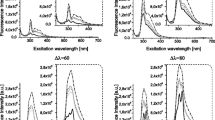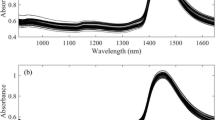Abstract
Front-face fluorescence spectroscopy (FFFS) was evaluated as a quality assurance process analytical technology (PAT) tool for infant milk formula (IMF) manufacture. Batches of first-stage IMF (60:40 whey protein:casein ratio) powder were produced with protein:fat:lactose ratios of 1.3:3.6:7.3, differing only in heat treatment applied prior to spray drying (72, 95, or 115 °C for 15 s). Each IMF powder was stored at 15 ± 2 °C and 37 ± 2 °C and analyzed at months 0, 3, 6, and 12. Partial least squares (PLS) models were developed for IMF in both powder and liquid states using FFFS spectra to predict pre-drying heat treatment temperature, soluble protein content, and storage time. Models developed using tryptophan emission spectra for IMF powder predicted storage time, pre-drying heat treatment temperature, and soluble protein content with RMSECV values of 0.3 months, 8.3 °C, and 1.01 g protein/100 g powder, respectively. IMF powders were rehydrated to 13% total solids and analyzed using the vitamin A emission spectra. Models developed for rehydrated IMF predicted storage time and pre-drying heat treatment temperature with RMSECV values of 1.5 months and 6.7 °C, respectively. Surface free fats were predicted with an RMSECV range of 0.12–0.20% (w/w of powder) in rehydrated IMF. PLS discriminant analysis models developed for both powder and liquid IMF samples successfully discriminated for storage temperature. This preliminary study demonstrates the strong potential of FFFS as a PAT tool for IMF quality assurance.





Similar content being viewed by others
References
Birlouez-Aragon, I., Nicolas, M., Metais, A., Marchond, N., Grenier, J., & Calvo, D. (1998). A rapid Fluorimetric method to estimate the heat treatment of liquid milk. International Dairy Journal, 8(9), 771–777. https://doi.org/10.1016/S0958-6946(98)00119-8.
Birlouez-Aragon, I., Sabat, P., & Gouti, N. (2002). A new method for discriminating milk heat treatment. French patent no. 2752941. International Dairy Journal, 12(1), 59–67.
Birlouez-Aragon, I., Pischetsrieder, M., Leclere, J., Morales, F., Hasenkopf, K., Kientsch-Engel, R., et al. (2004). Assessment of protein glycation markers in infant formulas. Food Chemistry, 87(2), 253–259.
Birlouez-Aragon, I., Locquet, N., Louvent, E., Bouveresse, D. J. R., & Stahl, P. (2005). Evaluation of the Maillard reaction in infant formulas by means of front-face fluorescence. Annals of the New York Academy of Sciences, 1043(1), 308–318.
Chávez-Servín, J. L., de la Torre Carbot, K., García-Gasca, T., Castellote, A. I., & López-Sabater, M. C. (2015). Content and evolution of potential furfural compounds in commercial milk-based infant formula powder after opening the packet. Food Chemistry, 166, 486–491. https://doi.org/10.1016/j.foodchem.2014.06.050.
Dal Zotto, R., De Marchi, M., Cecchinato, A., Penasa, M., Cassandro, M., Carnier, P., et al. (2008). Reproducibility and repeatability of measures of milk coagulation properties and predictive ability of mid-infrared reflectance spectroscopy. Journal of Dairy Science, 91(10), 4103–4112. https://doi.org/10.3168/jds.2007-0772.
de Sereys, A. L., Muller, S., Desic, S., Troise, A., Fogliano, V., Acharid, A., et al. (2014). Potential of the FAST index to characterize infant formula quality. Handbook of dietary and nutritional aspects of bottle feeding. Wageningen Academic Publishers (2014)
De Marchi, M., Fagan, C. C., O’Donnell, C. P., Cecchinato, A., Dal Zotto, R., Cassandro, M., et al. (2009). Prediction of coagulation properties, titratable acidity, and pH of bovine milk using mid-infrared spectroscopy. Journal of Dairy Science, 92(1), 423–432. https://doi.org/10.3168/jds.2008-1163.
Diez, R., Ortiz, M., Sarabia, L., & Birlouez-Aragon, I. (2008). Potential of front face fluorescence associated to PLS regression to predict nutritional parameters in heat treated infant formula models. Analytica Chimica Acta, 606(2), 151–158.
Dufour, E., & Riaublanc, A. (1997). Potentiality of spectroscopic methods for the characterisation of dairy products. I. Front-face fluorescence study of raw, heated and homogenised milks. Le Lait, 77(6), 657–670.
Dufour, E., Mazerolles, G., Devaux, M. F., Duboz, G., Duployer, M. H., & Mouhous Riou, N. (2000). Phase transition of triglycerides during semi-hard cheese ripening. International Dairy Journal, 10(1), 81–93. https://doi.org/10.1016/S0958-6946(00)00025-X.
GEA-Niro (2012). Analytical methods for dry milk products. www.niro.com/methods Accessed 28 Sept 2017
Guan, R.-F., Liu, D.-H., Ye, X. Q., & Yang, K. (2005). Use of fluorometry for determination of skim milk powder adulteration in fresh milk. Journal of Zhejiang University. Science. B, 6(11), 1101.
Hammami, M., Dridi, S., Zaïdi, F., Maâmouri, O., Rouissi, H., Blecker, C., & Karoui, R. (2013). Use of front-face fluorescence spectroscopy to differentiate sheep milks from different genotypes and feeding systems. International Journal of Food Properties, 16(6), 1322–1338.
Hartman, A. M., & Dryden, L. P. (1965). Vitamins in milk and milk products. Vitamins in milk and milk products.
Kamal, M., & Karoui, R. (2015). Analytical methods coupled with chemometric tools for determining the authenticity and detecting the adulteration of dairy products: a review. Trends in Food Science & Technology, 46(1), 27–48. https://doi.org/10.1016/j.tifs.2015.07.007.
Karoui, R., & De Baerdemaeker, J. (2007). A review of the analytical methods coupled with chemometric tools for the determination of the quality and identity of dairy products. Food Chemistry, 102(3), 621–640.
Kehoe, J. J., Remondetto, G. E., Subirade, M., Morris, E. R., & Brodkorb, A. (2008). Tryptophan-mediated denaturation of β-lactoglobulin A by UV irradiation. Journal of Agricultural and Food Chemistry, 56(12), 4720–4725.
Kelly, G. M., O’Mahony, J. A., Kelly, A. L., Huppertz, T., Kennedy, D., & O’Callaghan, D. J. (2015). Influence of protein concentration on surface composition and physico-chemical properties of spray-dried milk protein concentrate powders. International Dairy Journal, 51, 34–40. https://doi.org/10.1016/j.idairyj.2015.07.001.
Lacotte, P., Gomez, F., Bardeau, F., Muller, S., Acharid, A., Quervel, X., Trossat, P., & Birlouez-Aragon, I. (2015). Amaltheys: a fluorescence-based analyzer to assess cheese milk denatured whey proteins. Journal of Dairy Science, 98(10), 6668–6677.
Lešková, E., Kubíková, J., Kováčiková, E., Košická, M., Porubská, J., & Holčíková, K. (2006). Vitamin losses: retention during heat treatment and continual changes expressed by mathematical models. Journal of Food Composition and Analysis, 19(4), 252–276. https://doi.org/10.1016/j.jfca.2005.04.014.
Liu, X., & Metzger, L. (2007). Application of fluorescence spectroscopy for monitoring changes in nonfat dry milk during storage. Journal of Dairy Science, 90(1), 24–37.
Maher, P. G., Roos, Y. H., Kilcawley, K. N., Auty, M. A. E., & Fenelon, M. A. (2015). Levels of pentanal and hexanal in spray dried nanoemulsions. LWT - Food Science and Technology, 63(2), 1069–1075. https://doi.org/10.1016/j.lwt.2015.04.044.
Martens, H., & Martens, M. (2000). Modified Jack-knife estimation of parameter uncertainty in bilinear modelling by partial least squares regression (PLSR). Food Quality and Preference, 11(1–2), 5–16. https://doi.org/10.1016/S0950-3293(99)00039-7.
McCarthy, N. A., Gee, V. L., Hickey, D. K., Kelly, A. L., O’Mahony, J. A., & Fenelon, M. A. (2013). Effect of protein content on the physical stability and microstructure of a model infant formula. International Dairy Journal, 29(1), 53–59. https://doi.org/10.1016/j.idairyj.2012.10.004.
McSweeney, P., & Fox, P. (2009). Advanced Dairy Chemistry, Volume 3: Lactose, Water, Salts and Minor Constituents. Springer Science+ Business Media, New York, USA.
Miquel Becker, E., Christensen, J., Frederiksen, C., & Haugaard, V. (2003). Front-face fluorescence spectroscopy and chemometrics in analysis of yogurt: rapid analysis of riboflavin. Journal of Dairy Science, 86(8), 2508–2515.
Moros, J., Garrigues, S., & De la Guardia, M. (2007). Evaluation of nutritional parameters in infant formulas and powdered milk by Raman spectroscopy. Analytica Chimica Acta, 593(1), 30–38.
Mungkarndee, R., Techakriengkrai, I., Tumcharern, G., & Sukwattanasinitt, M. (2016). Fluorescence sensor array for identification of commercial milk samples according to their thermal treatments. Food Chemistry, 197(Part A), 198–204. https://doi.org/10.1016/j.foodchem.2015.10.083.
Murphy, E. G., Tobin, J. T., Roos, Y. H., & Fenelon, M. A. (2013). A high-solids steam injection process for the manufacture of powdered infant milk formula. Dairy Science & Technology, 1–13.
O’Donnell, C. P., Fagan, C., & Cullen, P. J. (2014). Process analytical technology for the food industry. Springer.
Pomerantsev, A. L., & Rodionova, O. Y. (2012). Process analytical technology: a critical view of the chemometricians. Journal of Chemometrics, 26(6), 299–310.
Qi, P. X., Ren, D., Xiao, Y., & Tomasula, P. M. (2015). Effect of homogenization and pasteurization on the structure and stability of whey protein in milk. Journal of Dairy Science, 98(5), 2884–2897.
Riley, B. S., & Li, X. (2011). Quality by design and process analytical technology for sterile products—where are we now? AAPS PharmSciTech, 12(1), 114–118.
Sahar, A., Boubellouta, T., Lepetit, J., & Dufour, É. (2009). Front-face fluorescence spectroscopy as a tool to classify seven bovine muscles according to their chemical and rheological characteristics. Meat Science, 83(4), 672–677. https://doi.org/10.1016/j.meatsci.2009.08.002.
Saricoban, C., & Yilmaz, M. T. (2010). Modelling the effects of processing factors on the changes in colour parameters of cooked meatballs using response surface methodology. World Applied Sciences Journal, 9(1), 14–22.
Schamberger, G. P., & Labuza, T. P. (2006). Evaluation of front-face fluorescence for assessing thermal processing of milk. Journal of Food Science, 71(2), C69–C74.
Singh, H., & Ye, A. (2010). Controlling milk protein interactions to enhance the reconstitution properties of whole milk powders—a minireview. Dairy Science & Technology, 90(2–3), 123–136.
Tajammal Munir, M., Yu, W., Young, B. R., & Wilson, D. I. (2015). The current status of process analytical technologies in the dairy industry. Trends in Food Science & Technology, 43(2), 205–218. https://doi.org/10.1016/j.tifs.2015.02.010.
Torre, M., San Andres, M., Vera, S., Montalvo, G., & Valiente, M. (2009). Retinol fluorescence: a simple method to differentiate different bilayer morphologies. Colloid and Polymer Science, 287(8), 951–959.
Vignolles, M.-L., Jeantet, R., Lopez, C., & Schuck, P. (2007). Free fat, surface fat and dairy powders: interactions between process and product. A review. Le Lait, 87(3), 187–236.
Williams, P. C. (2003). Near-infrared technology getting the best out of light. A Short Course in the Practical Implementation of Near Infrared Spectroscopy for the User. 1.1 ed. PDKProjects Inc., Nanaimo, Canada., 109.
Woodcock, T., Fagan, C. C., O’Donnell, C. P., & Downey, G. (2008). Application of near and mid-infrared spectroscopy to determine cheese quality and authenticity. Food and Bioprocess Technology, 1(2), 117–129. https://doi.org/10.1007/s11947-007-0033-y.
Woodcock, T., Downey, G., & O’Donnell, C. P. (2009). Near infrared spectral fingerprinting for confirmation of claimed PDO provenance of honey. Food Chemistry, 114(2), 742–746. https://doi.org/10.1016/j.foodchem.2008.10.034.
Zhao, M., Downey, G., & O’Donnell, C. P. (2015). Dispersive Raman spectroscopy and multivariate data analysis to detect offal adulteration of thawed beefburgers. Journal of Agricultural and Food Chemistry, 63(5), 1433–1441.
Acknowledgements
We thank Mr. Andrea Badellino from School of Biosystems and Food Engineering, University College Dublin, Belfield, Dublin 4, Ireland for his technical assistance with experimental work.
Funding
This research receive funding from the Irish Department of Agriculture, Food and the Marine through its Food Institutional Research Measure (FIRM) initiative (project 11/F/052).
Author information
Authors and Affiliations
Corresponding author
Rights and permissions
About this article
Cite this article
Henihan, L.E., O’Donnell, C.P., Esquerre, C. et al. Quality Assurance of Model Infant Milk Formula Using a Front-Face Fluorescence Process Analytical Tool. Food Bioprocess Technol 11, 1402–1411 (2018). https://doi.org/10.1007/s11947-018-2112-7
Received:
Accepted:
Published:
Issue Date:
DOI: https://doi.org/10.1007/s11947-018-2112-7




